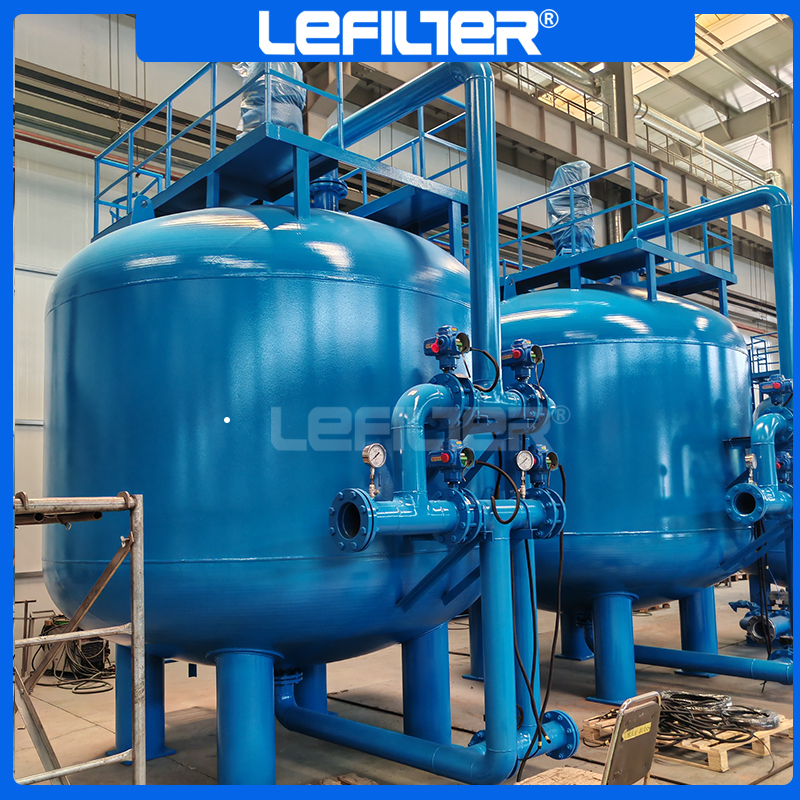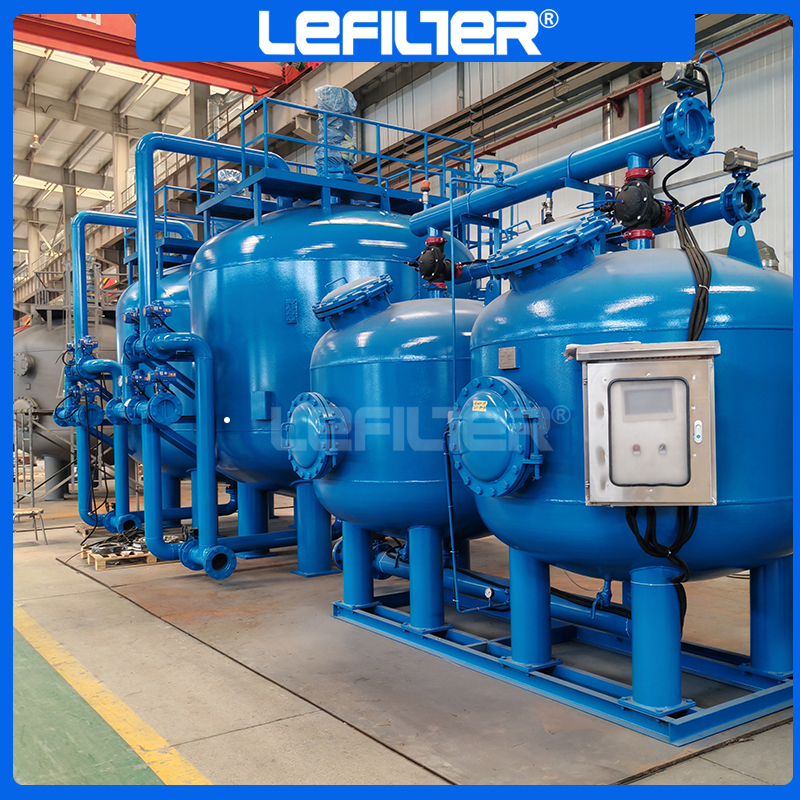Automation in Multimedia Filtration Systems
DATE:2024-09-27 Number of views: 1 Source:dongwenhui
In recent years, automation has transformed many aspects of industrial processes, including water treatment. Multimedia filtration systems, which utilize multiple layers of filter media to remove contaminants from water, have benefited significantly from advancements in automation and modern control technologies. We explore how automation enhances the performance of multimedia filters, focusing on innovations in valve control, backwashing, and real-time monitoring.
Enhancing Performance through Automation
Automation in multimedia filtration systems introduces a range of improvements that lead to better performance, increased efficiency, and reduced operational costs. Here are some key ways automation has enhanced these systems:
Improved Control: Automated control systems allow for precise regulation of flow rates and pressures, optimizing the filtration process. This ensures that the system operates within ideal parameters, enhancing overall efficiency.
Real-Time Monitoring: Automation enables continuous monitoring of critical parameters such as turbidity, flow rate, and pressure differentials. This real-time data allows operators to make informed decisions and quickly address any issues that arise.
Predictive Maintenance: By analyzing trends in the data collected, automated systems can predict when maintenance is required, preventing unexpected downtime and costly repairs.
Increased Reliability: Automated systems reduce the likelihood of human error, ensuring consistent operation and improving the reliability of the filtration process.

Common Automation Technologies Used in Multimedia Filtration Systems
Several automation technologies are commonly implemented in multimedia filtration systems:
Programmable Logic Controllers (PLCs): These devices control various functions of the filtration system, including flow regulation, backwashing sequences, and alarm management.
Smart Sensors: Advanced sensors can detect changes in water quality parameters and system performance, providing crucial data for decision-making.
Variable Frequency Drives (VFDs): VFDs adjust the speed of pumps and motors based on real-time demand, optimizing energy consumption while maintaining adequate flow rates.
Automated Valves: These valves facilitate automatic control of water flow and pressure, enabling more efficient operation of the filtration system.
Data Acquisition Systems: These systems collect and analyze data from multiple sources, providing insights into system performance and helping operators optimize processes.
Reducing Water and Energy Consumption
One of the significant advantages of automating multimedia filtration systems is the reduction of water and energy consumption:
Efficient Backwashing: Automated backwashing systems ensure that filters are cleaned only when necessary, minimizing water waste. By using data on flow rates and pressure differentials, these systems can determine the optimal time for backwashing.
Optimized Pump Operation: With VFDs, pumps operate at variable speeds depending on demand, leading to lower energy consumption. This adjustment not only reduces operational costs but also extends the lifespan of the equipment.
Lower Chemical Use: Automated monitoring can help identify when and how much chemical treatment is needed, minimizing excess usage and reducing overall operational costs.

Predicting Filter Clogging
Automation technologies can enhance the ability to predict filter clogging:
Data Analysis: Automated systems collect data over time, allowing for the analysis of trends that indicate potential clogging issues. For example, a gradual increase in pressure drop across the filter may signal that cleaning is needed soon.
Machine Learning Algorithms: Some advanced systems use machine learning algorithms to improve prediction accuracy. By learning from historical data, these systems can forecast when a filter is likely to clog, allowing operators to take preventative action.
Automated Backwashing Systems
Automated backwashing systems play a crucial role in maintaining the efficiency of multimedia filters:
How They Work: During backwashing, flow is reversed through the filter media, dislodging accumulated contaminants. Automated systems can initiate backwashing based on preset criteria, such as pressure differentials or time intervals.
Optimized Timing: By monitoring real-time data, these systems can determine the optimal timing for backwashing, ensuring that the filter media is cleaned effectively without unnecessary water waste.
Minimal Downtime: Automation allows for seamless transitions between filtration and backwashing, reducing downtime and maintaining system performance.

Cost of Adding Automation
Implementing automation in multimedia filtration systems does come with costs, but the benefits often outweigh the initial investment:
Initial Capital Investment: The cost of automation technologies can vary widely, depending on the complexity of the system and the specific technologies chosen. Budgeting for these costs is essential during the design phase.
Long-Term Savings: While the upfront costs may be significant, the long-term savings achieved through reduced operational costs, improved efficiency, and decreased maintenance needs often justify the investment.
Return on Investment (ROI): A well-implemented automated system can lead to a positive ROI within a few years, making it an attractive option for many facilities.
Smart Sensors and Filter Monitoring
Smart sensors are integral to modern automated multimedia filtration systems, enhancing monitoring capabilities:
Continuous Monitoring: Smart sensors provide continuous feedback on key performance indicators, such as turbidity and pressure. This data allows for proactive management of the filtration process.
Alerts and Alarms: Automated systems can generate alerts when parameters deviate from acceptable ranges, allowing operators to take immediate corrective actions.
Data Integration: Smart sensors can integrate with larger data acquisition systems, providing comprehensive insights into system performance and facilitating better decision-making.
Suitability of Automated Systems for Various Industries
Automated multimedia filtration systems are versatile and can be adapted for use in various industries:
Water Treatment Plants: These systems are commonly used in municipal water treatment facilities, where efficiency and reliability are paramount.
Industrial Applications: Industries such as food and beverage, pharmaceuticals, and manufacturing benefit from automated filtration systems to ensure consistent water quality.
Agriculture: Automated filtration systems can help manage water quality in irrigation systems, ensuring optimal conditions for crop growth.
Desalination: In desalination plants, automation plays a crucial role in maintaining filter performance, ensuring effective removal of contaminants from seawater.

Conclusion
Automation has revolutionized multimedia filtration systems, enhancing their performance and efficiency through modern control technologies. By implementing automated solutions, facilities can achieve better water quality, reduce operational costs, and ensure more reliable filtration processes. As industries continue to seek ways to improve water treatment, the role of automation will only become more significant.
FAQ
1. How has automation improved multimedia filtration systems?
Automation enhances control, real-time monitoring, predictive maintenance, and overall reliability of multimedia filtration systems.
2. What are the most common automation technologies used in these systems?
Common technologies include PLCs, smart sensors, VFDs, automated valves, and data acquisition systems.
3. How does automation help reduce water and energy consumption?
Automation optimizes backwashing processes and pump operation, leading to lower water waste and energy use.
4. Can automated systems predict filter clogging?
Yes, automated systems can analyze data trends to predict potential clogging and initiate preventative maintenance.
5. How do automated backwashing systems work?
These systems reverse water flow through the filter media at optimal times based on real-time data, effectively cleaning the media.
6. What is the cost of adding automation to a multimedia filtration system?
Costs vary depending on technology complexity, but long-term savings often justify the initial investment.
7. How do smart sensors improve filter monitoring?
Smart sensors provide continuous data on performance indicators, allowing for proactive management and alerts for corrective action.
8. Are automated systems suitable for all industries?
Yes, automated multimedia filtration systems can be adapted for various industries, including water treatment, agriculture, and manufacturing.
Industry Solutions
Pure Water /Ultra Pure Water System


